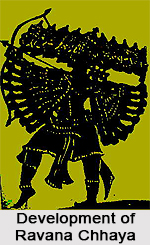 The development of Ravana Chhaya has taken place over centuries. To trace the origin and development of Ravana Chhaya it is useful to begin with the history of shadow-theatre in general and that of the Indian tradition in particular. Many people consider shadow-play to be the oldest of all theatre-forms. Some scholars maintain that it began in India while others are emphatic about its origin in China. There is a similar legend about the origin of Turkish shadow-theatre. It cannot be denied that legends often contain facts of an obscure past but it is equally true that they are highly coloured by imagination and therefore, cannot be relied upon as historical evidence. Paintings and writings dating back to the early part of the Sung dynasty (A.D. 960-1279), however, provide evidence of the existence of shadow-theatre in China. The tradition of shadow-theatre in Java seems to be equally ancient.
The development of Ravana Chhaya has taken place over centuries. To trace the origin and development of Ravana Chhaya it is useful to begin with the history of shadow-theatre in general and that of the Indian tradition in particular. Many people consider shadow-play to be the oldest of all theatre-forms. Some scholars maintain that it began in India while others are emphatic about its origin in China. There is a similar legend about the origin of Turkish shadow-theatre. It cannot be denied that legends often contain facts of an obscure past but it is equally true that they are highly coloured by imagination and therefore, cannot be relied upon as historical evidence. Paintings and writings dating back to the early part of the Sung dynasty (A.D. 960-1279), however, provide evidence of the existence of shadow-theatre in China. The tradition of shadow-theatre in Java seems to be equally ancient.
The development of Indian shadow play, particularly the Ravana Chhaya, is attributed by many to the shadow theatre in Java known as the Wayang Kulit. Scholars differ about the origins of Wayang. Some believe that it has an Indian origin while others hold that it id Indonesian in origin. However, there has been seen a lot of historical evidence which points to the Indian origins of the Wayang and its linkage to the Ravana Chhaya.
In Wayang-Purva, the earliest type of Wayang in Java, themes of the plays are always drawn from Ramayana and Mahabharata just as in the Ravanna Chhaya. Moreover, in the field of traditional human-theatre, the Wayang Topeng and Wayang Wong, have many similarities with the Chhau dance-theatre of Orissa. The regions in India where the tradition of shadow-theatre now also survives, especially that which was earlier known as Kalinga, had long cultural, commercial and political ties with Java, so much so that a part of this island was known as Kaling. The most important factor that links the Wayang with the Oriya Ravana Chhaya is that there are a number of technical terms which bear similarity with Oriya language words. Given these undisputed facts, it is reasonable to assume that Ravana Chhaya, the traditional shadow-theatre of Kalinga inspired Wayang in Java, not vice-versa since the puppet figures of Ravanachhaya are less sophisticated and have a more primitive quality in conception and definition. The close relationship between Kalinga and Wayang shadow-theatre is further borne out by the fact that one of the ancient lakons, that is, short dramatic sketches to refresh the memory of a dalang, bears the name Bambang Kalinga. There is thus a strong possibility that Ravana Chhaya and Wayang were closely related more, than 1000 years ago.
In the course of its development, the Ravana Chhaya was influenced to a great extent by the religious forces of Buddhism and Jainism. Jainism was preached and became prevalent in Kalinga by Mahavira Vardhamana as far back as the 6th century B.C. Moreover, Buddhism also made its presence felt in Kalinga at around the 3rd century B.C. when Ashoka invaded the land. When the great Buddhist saint Nagarjuna came to Orissa he converted the then King Munja to Buddhism and built many Buddhist monasteries in Orissa. Thus the impact of these two religions on the development of the Ravana Chhayas has been a major factor. Its most profound impact can be seen in the treatment meted out to Ravana. Similar to their religious beliefs, Ravana is not held to be a demon-king but on the contrary is treated with much respected.
Thus the development of the Ravana Chhaya has been a long time in the making. However, in the current scenario, this art form is slowly fading away and is fast on the decline in Orissa, surviving only in isolated instances. If steps are not taken towards the revival of this theatre form, it stands the danger of being completely washed away.




